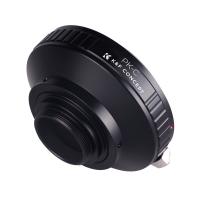Which Microscope Has The Highest Magnification ?
The electron microscope has the highest magnification among all types of microscopes.
1、 Electron Microscope: Highest magnification in microscopy, using electron beams.
The microscope with the highest magnification is the Electron Microscope. It utilizes electron beams instead of light to magnify the specimen, allowing for much higher levels of magnification and resolution compared to traditional light microscopes. The electron microscope has revolutionized the field of microscopy, enabling scientists to observe and study objects at the nanoscale level.
There are two types of electron microscopes: the Transmission Electron Microscope (TEM) and the Scanning Electron Microscope (SEM). The TEM works by passing a beam of electrons through a thin specimen, while the SEM scans the surface of the specimen with a focused beam of electrons. Both types of electron microscopes can achieve magnifications of up to several million times, far surpassing the maximum magnification of light microscopes, which is typically around 2000 times.
The high magnification of electron microscopes allows scientists to study the fine details of cells, tissues, and even individual atoms. This has been crucial in various scientific fields, including biology, materials science, and nanotechnology. Electron microscopes have been instrumental in advancing our understanding of cellular structures, the arrangement of atoms in materials, and the development of new technologies.
It is important to note that the field of microscopy is constantly evolving, and new advancements are being made regularly. While the electron microscope currently holds the record for the highest magnification, it is possible that new technologies or techniques may emerge in the future that could surpass its capabilities. Nonetheless, as of now, the electron microscope remains the most powerful tool for magnifying and visualizing objects at the nanoscale.

2、 Scanning Tunneling Microscope: Achieves atomic-scale resolution through quantum tunneling.
The Scanning Tunneling Microscope (STM) is widely regarded as the microscope with the highest magnification. It is a powerful tool that allows scientists to achieve atomic-scale resolution through a phenomenon known as quantum tunneling.
The STM was invented in 1981 by Gerd Binnig and Heinrich Rohrer, who were awarded the Nobel Prize in Physics in 1986 for their groundbreaking work. Unlike traditional microscopes that use light or electrons to magnify objects, the STM operates on the principle of quantum tunneling. This phenomenon occurs when a particle passes through a barrier that, according to classical physics, it should not be able to penetrate. In the case of the STM, a sharp metal tip is brought very close to the surface of a sample, and a small voltage is applied. Electrons can then tunnel between the tip and the sample, creating a measurable current that is used to generate an image.
The STM has revolutionized the field of nanotechnology by allowing scientists to visualize and manipulate individual atoms and molecules. It has been used to study a wide range of materials, including metals, semiconductors, and biological samples. With its exceptional resolution, the STM has provided valuable insights into the atomic structure and properties of various materials, leading to advancements in fields such as materials science, chemistry, and physics.
In recent years, there have been advancements in microscopy techniques that have pushed the boundaries of magnification even further. For example, the development of aberration-corrected electron microscopes has allowed for atomic-scale imaging with improved resolution. However, the STM remains unparalleled in its ability to directly image and manipulate individual atoms, making it the microscope with the highest magnification for atomic-scale resolution.

3、 Atomic Force Microscope: Measures forces between a probe and sample surface.
The microscope with the highest magnification is the Atomic Force Microscope (AFM). The AFM is a powerful tool used in nanotechnology and materials science to measure forces between a probe and a sample surface. It operates by scanning a sharp probe over the surface of a sample, and the interaction forces between the probe and the sample are measured and used to create a high-resolution image.
The magnification of an AFM depends on various factors, including the size of the probe and the scanning range. In general, AFMs can achieve magnifications up to the atomic scale, allowing researchers to observe individual atoms and molecules on a surface. This level of magnification is far beyond what traditional light microscopes can achieve.
It is important to note that the magnification of an AFM is not solely determined by the instrument itself, but also by the properties of the sample being studied. The surface roughness and the type of material being imaged can affect the achievable magnification. Additionally, the resolution of an AFM is not solely determined by magnification but also by factors such as the sharpness of the probe and the sensitivity of the detection system.
In recent years, advancements in AFM technology have further improved its magnification capabilities. For example, the development of high-resolution probes and advanced imaging modes has allowed for even finer details to be resolved. Additionally, the integration of AFMs with other techniques, such as scanning electron microscopy, has enabled researchers to obtain complementary information and enhance the overall imaging capabilities.
In conclusion, the Atomic Force Microscope is the microscope with the highest magnification. Its ability to measure forces between a probe and a sample surface allows for imaging at the atomic scale, providing valuable insights into the nanoscale world. Ongoing advancements in AFM technology continue to push the boundaries of magnification and resolution, further expanding its applications in various scientific fields.

4、 X-ray Microscope: Utilizes X-rays for high-resolution imaging.
The X-ray microscope is a powerful tool that utilizes X-rays for high-resolution imaging. It is known for its ability to provide detailed images of objects at the atomic level, making it one of the most advanced microscopes available today.
The X-ray microscope works by using a beam of X-rays to scan the sample being observed. These X-rays interact with the atoms in the sample, producing a signal that can be detected and used to create an image. Because X-rays have a much shorter wavelength than visible light, they can resolve much smaller details, allowing for higher magnification and better resolution.
One of the key advantages of the X-ray microscope is its ability to image samples that are difficult or impossible to observe with other types of microscopes. For example, it can be used to study the structure of materials at the atomic level, such as crystals or nanoparticles. It can also be used to examine biological samples, such as cells or tissues, with high resolution.
In recent years, there have been significant advancements in X-ray microscopy technology, leading to even higher magnification and better image quality. For example, the development of synchrotron radiation sources has allowed for the production of highly intense and focused X-ray beams, enabling researchers to study samples with unprecedented detail.
Overall, the X-ray microscope is a cutting-edge tool that offers the highest magnification and resolution currently available in microscopy. Its ability to image samples at the atomic level makes it an invaluable tool for a wide range of scientific disciplines, from materials science to biology.








































